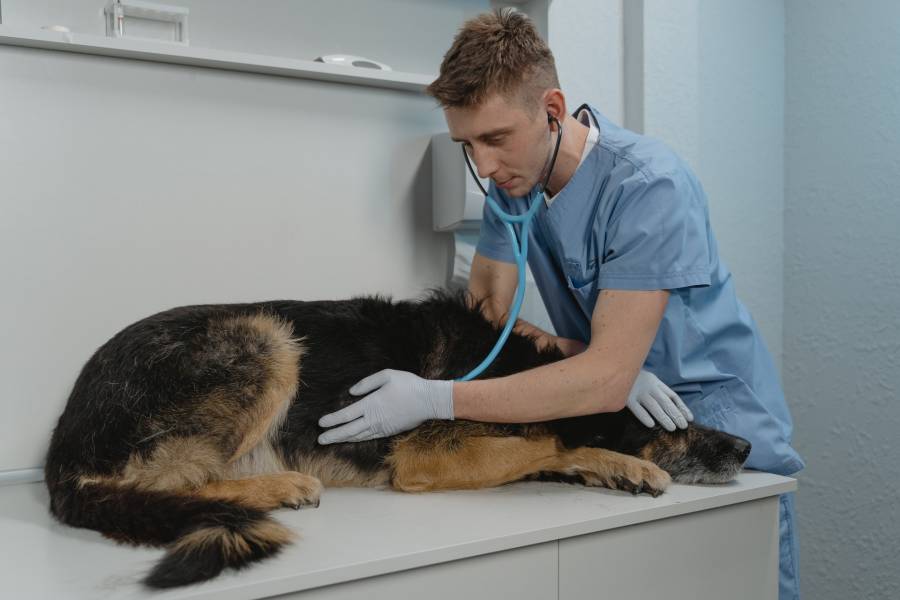Quick Navigation
Dog poop is often affected when your dog goes through some infection or illness.
If your dog’s poop looks different than before, it may be a cause for concern.
But what if your dog’s poop is like jelly with blood?
Surprisingly, it is not that uncommon and may appear due to several reasons.

To figure out what to do about your dog’s poop being like jelly with blood, you first need to get to the cause of it.
Here are some reasons why this may happen:
1. Viral/Bacterial Infections
A viral or bacterial infection in your dog usually results in diarrhea and also blood in their poop.
It may be causing your dog’s poop to look like jelly with blood.
Dogs can very quickly become infected through virus particles in the air.
Some such infections include canine distemper, canine influenza, and canine hepatitis.
If your dog is pooping blood that looks like jelly, you may want to get your dog tested for these infections.
Other signs of infection in your dog, aside from bloody stool, could be fever, red eyes, lethargy, shivering, loss of appetite, crankiness, coughing, and vomiting.
You may also want to look for an increased wax or pus-like discharge with a bad odor.
The immediate treatment for these infections is in the form of antibiotics.
2. Parvovirus
Canine parvovirus is highly contagious among dogs.
It spreads through direct contact with an infected dog or indirect contact with infected objects.
Infected or contaminated objects can include surfaces can include collars and leashes, food and water bowls, and just about every surface an infected dog makes contact with.
You may have often heard it in the expression that the dog has ‘parvo.’ If your dog has poop like jelly with blood, there is a chance it is because of parvovirus.
In the early stages, parvovirus may appear in profuse, bloody diarrhea, vomiting, loss of appetite, dehydration, lethargy, weakness, and collapse.
If your dog has not received a parvovirus vaccination or is a puppy under four months old, they are most at risk.
Based on your dog’s history, physical examination, and laboratory tests, fecal testing can confirm the final diagnosis.
If your dog has poop like jelly with blood, you should get it tested for parvovirus.
Since parvovirus is contagious, you should isolate it and practice proper hygiene using disinfecting agents; if your dog has tested positive for it.
Beware that parvovirus can be fatal, so proper treatment is necessary.
3. Hematochezia
Hematochezia is another dog occurrence that can explain dog poop like jelly with blood.
Blood flowing through the anus is referred to as hematochezia.
It is characterized as bright red in appearance and could be present both in the stool or the bloodshed after the dog is done defecating.
Hematochezia is usually caused when there is bleeding in the upper digestive tract of your dog. It may, however, also be in the lower GI, the colon, or the rectum.
Causes of hematochezia in dogs include clotting disorders, colitis, IBS (inflammatory bowel syndrome), intestinal ulcers, prostate disease, and other illnesses and disorders.
Hematochezia is treated depending on its severity of it.
For instance, a mild form may need dietary changes and laxatives or probiotics, whereas a more severe condition may need veterinary attention and even hospitalization.

4. Hemorrhagic Gastroenteritis (HGE)
Acute hemorrhagic diarrhea syndrome is another name for hemorrhagic gastroenteritis (AHDS).
A previously healthy dog will suddenly develop bloody vomiting and diarrhea.
The poop will often look covered in strawberry or raspberry-like jelly.
This condition occurs when blood from the stomach and intestines mix with diarrhea.
Hemorrhagic gastroenteritis (HGE) usually occurs due to bacteria, food sensitivity, your dog consuming something it should not have, or even stress.
However, the exact cause is unknown. The good news is that it is not contagious.
Dogs more likely to get HGE to include Yorkshire terriers, Pekingese, miniature schnauzers, and toy poodles.
If you suspect that your dog has HGE, you should take your dog to the vet right away.
Treatment for HE includes IV fluids, antibiotics, and a vet-approved diet.
While it may seem fatal, it usually is not when treated right away.
5. Rectal Tumors
One of the symptoms of rectal tumors is bloody stool.
It is why, if your dog has poop like jelly with blood, a possible cause is a rectal tumor.
The most common rectal tumor in dogs is carcinoma, in which cancer cells form in the tissues of the rectum.
Other symptoms of a rectal tumor in dogs include weight loss, swelling in the perianal region, constipation, pain when defecating, and excessive thirst and urination.
Your dog needs immediate care from a veterinarian if it exhibits symptoms of a rectal tumor.
Only surgery can probably help your dog in this case.
Tests that examine the rectum and colon diagnose such tumors among dogs.
Treatment At Home
There are some treatments that you may follow at home.
However, this does not mean that your pet does not need a vet’s attention.
The cause is severe enough to require a vet’s expertise in most cases.
Colitis for example, characterized by a loose, runny poop with jelly-like blood may be colitis, an inflammation of the lower part of the bowel that will go away in a few days, but some cases require treatment.
Straining may result in bright red spots, which are typically nothing to worry about.
Here are the immediate remedies and treatments you can follow:
Diet
The cause of your dog’s poop being like jelly with blood may be its diet.
Your dog may have consumed something which is making it sick.
So, if your dog is experiencing a bloody stool, you may help fix it with a better diet.
It may be beneficial to change to a diet that is highly digestible or include more fiber.
You can safely feed your dog boiled white meat chicken (without skin or bones), white rice, and a teaspoon to a tablespoon (depending on the size of the dog) of canned pumpkin for a few days.
Additionally, you may want to incorporate into your dog’s diet include fish oil, vegetables (leafy greens and yellow-orange vegetables), mushrooms, fiber, fruits, and bone broth.
Probiotics
A probiotic supplement might be useful in treating a small amount of mucus in the stool of a dog that is otherwise healthy.
Request recommendations from your veterinarian or look for probiotics made especially for dogs.
You should call your veterinarian if your dog’s poop does not get better after a few days on a bland diet or if its symptoms worsen.
Final Thoughts
It is helpful to find out what different forms of your dog’s poop mean, not just for bloody stools but in other forms as well.
This way, you can tend to your dog right away and take it to the vet when needed.
In the case of dog poop like jelly with blood, it is rarely fatal as it is commonly just an infection.
However, in cases like rectal tumors, it may be serious.
It is why you should give immediate attention to your dog in the case of dog poop like jelly with blood.

A passionate content creator on pet behavior, nutrition choices, and health, Mike is an experienced pet expert. He has been writing on multiple websites to compensate for his passion for cats. Mike grieves around plenty of pets in his parents’ house. At the start of his career, he had a sturdy intention to be a part of pet care by any means.
With his affiliation to Purrfect n’ Pawesome, he found a way to satiate his craving to participate in pet health, wellness, and behavior analysis. He has been a significant part of our team and a major contributor in equipping our site with useful, authentic, and research-backed articles.
“I love pets as much as I love to travel to explore multiple places and lifestyles. I have been attached to this pawsome platform for many years, and my experience regarding pets has enhanced significantly by using various devices to write articles. I believe in writing my thoughts and experiences, so I try to write down the experience and learnings for my readers no matter where I am and what my mood is.”






